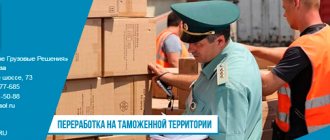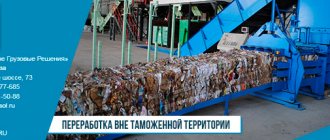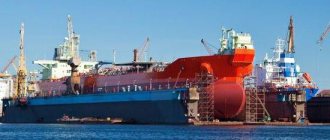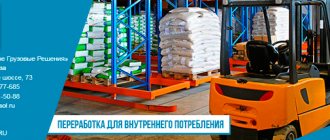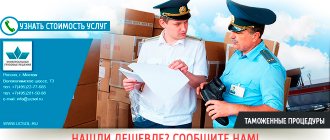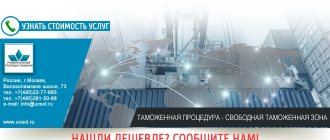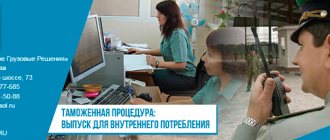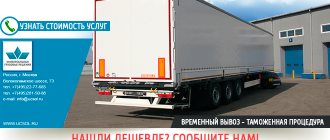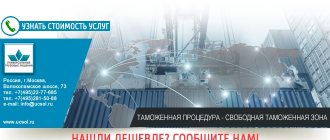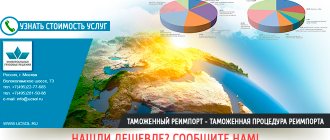Contents of the customs procedure
The essence of the customs procedure for processing outside the customs territory mirrors the customs procedure for processing within the customs territory. When processing outside customs, the same actions are performed, but only EAEU goods exported from its territory are processed in order to bring back the processed products in one form or another into the customs territory. Exported EAEU goods after export receive the status of foreign.
ATTENTION! We work only with legal entities.
The operations that constitute the essence of processing include:
- production, assembly, disassembly of goods;
- processing;
- repair and modernization.
When importing modified imported goods into the EAEU customs territory after completion of the processing procedure outside the customs territory, foreign products are, as a rule, placed under the release procedure for domestic consumption. In this case, the cost of services is the cost of services for processing goods or performing repair operations. It is also possible to apply the customs re-import procedure in case of warranty repairs abroad. But the re-import procedure is not used if the processed products were obtained from goods released for domestic consumption and having a defect due to which warranty repairs were made.
Customs payments
No export payments are made upon export. There is no domestic tax exemption, refund or refund of such payments. The declarant pays only the fee for cargo clearance.
When importing products into the territory of the EAEU, partial exemption from VAT and duties is available. Excise taxes are paid in full.
Replacement of processed products with identical foreign goods is not allowed. An exception is only for cases when products are exported for repair or replacement of parts that have no analogues. Or when representatives of the Customs Union do not identify the imported cargo according to the Customs Code.
Conditions of the customs procedure for processing outside the customs territory
The customs procedure for processing outside the customs territory applies:
- if goods were previously placed under the customs procedure of release for domestic consumption and benefits for the payment of import duties and taxes are applied together with restrictions on the disposal of products;
- if the products are exported for the purpose of repair and have the status of foreign goods until they are placed under the procedure;
- if the goods are placed under the customs procedure for temporary export (before the procedure expires);
- if these are vehicles of international transportation, in respect of which it is necessary to carry out operations with the exception of warranty repairs, repairs required after an accident or force majeure, maintenance.
Without import into the customs territory of the EAEU, goods placed under the customs procedure of temporary import and vehicles of international transportation, subject to exceptions, are placed under the customs procedure for processing outside the customs territory.
Moreover, goods are placed under the customs procedure of processing outside the customs territory subject to certain conditions:
- if there is a document reflecting the processing conditions. This may be a declaration for goods if repairs are carried out outside the customs territory;
- if it is possible to identify goods after processing;
- when ensuring payment of export customs duties (if provided for by law);
- subject to restrictions and prohibitions.
Identification of goods in processed products can be done in different ways: by preliminary labeling, photography, description of characteristics or analysis of samples of processed products and comparison of them with samples of exported goods. The documentary identification method can also be used when processing technology is analyzed based on the submitted documentation.
The processing conditions document must contain certain information:
- about the authorized body of the Member State that issued the document;
- about the document holder;
- about the person who will perform the processing;
- about the processed products and what should be the result;
- on documentation defining the rights to own goods and use them;
- about output standards, i.e. the number of processed products or the percentage of initial products in processed products;
- about ongoing processing operations;
- on the methodology for identifying goods in processed products;
- processing time;
- the possibility of replacing goods with equivalent ones - this operation is allowed in the case of repair of products or processing of goods transported by pipeline transport. Then the import of equivalent goods is possible before the export of products intended for processing;
- the customs authority responsible for the initiation and completion of the customs procedure for processing outside the customs territory.
Before placing goods under the procedure of processing or alteration in any way, except for repair, outside the customs territory, the declarant is required to obtain permission in the established form to carry out the procedure. The point is selected either in accordance with the location of the declarant, or in accordance with the place where the processing activities will be carried out.
If the goods are being repaired and no other actions will be performed with them, you do not need to obtain permission. In this option, the declaration itself will act as a permit, which determines the procedure for placing goods under a procedure that entails a change in the final characteristics. It also specifies the processing conditions.
Another important condition for processing operations is compliance with the deadlines - 2 years for processing goods outside the customs territory, which are established in the document defining the conditions for processing goods. Moreover, the last date of the period is considered to be the day the goods are placed under the customs procedure.
The period can be extended upon application by submitting it no later than 10 days after the expiration of the previously agreed period. Then the procedure is resumed, but the period is counted from the last day of the processing procedure.
The following are NOT considered processing:
- growing plants;
- raising animals, fish and birds;
- operations to ensure the safety of goods for their subsequent sale or transportation;
- use of imported products as means of production;
- copying audio and video data.
Temporary removal
The customs procedure is used when testing for performance is required, and it is also necessary to configure equipment abroad or when temporary removal of equipment abroad for repairs is necessary. You are not sure whether the product is defective or faulty. How to take equipment abroad for repairs? This is the easiest way - we send the goods for export (we place them under the temporary export procedure). The manufacturer carries out the necessary work and operations to set up the equipment, test it and draws up a conclusion about the serviceability of the equipment, and also submits a document (conclusion) indicating that the equipment is in working order and no repairs have been carried out. After this, the equipment is re-imported into Russia (to the territory of the customs union) using the customs procedure - Re-import.
Attention, important to know!
If the work (examination, etc.) carried out by the manufacturer is paid, then you are required to pay duty and taxes on the cost of the work. The basis of accrual is the cost of the work performed.
Required documents for temporary export:
- contract agreement, which will specify what operations will be performed with equipment outside the territory of Russia and the Customs Union. For temporary export, it is allowed to indicate in the contract any operations, with the exception of repairs and replacement with new equipment.
- issued customs declaration (CCD) if foreign equipment is exported.
- proforma invoice/invoice.
In the event that during temporary export defective goods are discovered, and after an examination it is revealed that the goods need to be repaired or need to be replaced with similarly new equipment. In this case, you need to declare the procedure - “PROCESSING OUTSIDE THE CUSTOMS TERRITORY” without presenting the goods to the customs authority. Otherwise, when the goods remain unchanged during temporary export, they are placed under the customs procedure of Re-import upon import into Russia.
Simplified procedure for temporary export based on Federal Law 289
Article 283. Temporary export of scientific or commercial samples
- Scientific or commercial samples temporarily exported from the Russian Federation outside the Customs Union for testing, research, testing, verification, experimentation, experimentation or demonstration or use in testing, research, testing, inspection, experimentation, experimentation or demonstration , are subject to customs declaration in a simplified manner in accordance with the provisions of this article.
- Scientific or commercial samples temporarily exported from the Russian Federation outside the Customs Union in the personal luggage of a passenger, by express mail, as well as scientific or commercial samples, the cost of which does not exceed 300,000 rubles, at the request of the declarant, can be declared in a simplified manner using as customs declaration of a written statement from the organization - the sender of scientific or commercial samples. The form of such an application is established by the federal executive body authorized in the field of customs affairs.
Information for the declarant of the customs procedure for processing outside the customs territory
The responsibilities of the person filing the declaration are as follows:
- comply with the deadlines for carrying out relevant actions;
- control the processing process, including ensuring control over the yield standards of modified products;
- ensure the identification of goods in processed products using the methods specified in Articles 167 and 180 of the EAEU Customs Code;
- submit reports to the appropriate customs office (Order of the Federal Customs Service of Russia dated April 13, 2011 No. 778), in which permission to change products was obtained, or in the region of operation of which the corresponding customs declaration was filed (if the processing operation is exclusively repair).
Getting permission
Permission to use the regime can be obtained by any vehicle entity, even if it does not carry out processing. The permit is transferable. The processing permit, in addition to the person receiving the permit, also indicates processing organizations that provide services for processing goods (Order of the State Customs Committee of Russia dated September 15, 2003 No. 1014).
To obtain a permit, you must submit a written application to the customs authority, indicating the information:
- about the applicant;
- about the person performing operations for processing goods;
- about the products that will be placed under the processing procedure, waste and residues generated during the operation;
- about the manipulations to which the goods will be subjected and the time it will take;
- about the place of processing;
- about the output rate;
- on methods for identifying imported products in manufactured goods;
- on the replacement of imported goods with equivalent ones;
- on the supply of products before the import of foreign raw materials;
- on commercial use of waste;
- about processing times.
The standard period for consideration of an application is 15 days or 30 days in case of extension. If a declaration is used – 1 business day.
Identification of foreign products
Methods of possible identification are established by the Customs Code of the Customs Union:
- marking, stamping, sealing on foreign products;
- photography, descriptive characteristics;
- comparison by analyzing samples and samples of raw materials and manufactured goods;
- use of serial numbers;
- other identification methods established based on the processing method and production technology used.
Determination of yield standards
Yield standards are established by the applicant taking into account the actual processing conditions or by the competent authorities (under special conditions). Perhaps in this case, expert opinions will be required, but such documents are not mandatory.
Ensuring payment of customs duties
The applicant must provide security for payment of customs duties if the customs authority believes that the product can be released for domestic production. Later, when the obligations in accordance with the processing procedure are fulfilled, the security is returned.
Collateral can be deposited through:
- Money;
- bank guarantee;
- sureties;
- property collateral.
Completion of the customs procedure
Completion of the customs procedure for processing outside the customs territory during its validity period as a result of placing products (one or more batches) under the procedures:
- export;
- re-import;
- re-export.
But there are exceptions. For example, the customs export procedure is impossible if the legislation establishes the obligation to return goods placed under the customs processing procedure to the customs territory of the Union.
Waste, residues and production losses
Residues of foreign goods resulting from processing operations outside the customs territory of the Union in accordance with the norms for the output of processed products are subject to placement under customs procedures and are considered as goods exported outside the customs territory of the Union in this state.
If waste is recognized as unsuitable for its further commercial use or such waste is subject to burial, neutralization, recycling or destruction in another way, then it is not subject to placement under customs procedures, acquires the status of goods of the Union and is considered not to be under customs control from the date of its recognition as unsuitable for further use. commercial use or from the date of submission to the customs authority of documents confirming the fact of burial, neutralization, recycling or destruction of generated waste in another way or the fact of their transfer for such operations.
Payment of export and import duties
The declarant becomes obligated to pay export customs duties from the moment of registration of the customs declaration in the customs procedure for processing outside the customs territory in relation to goods that are subject to export customs duties. In other words, the declarant, when placing EAEU goods subject to export customs duties under the customs procedure of processing outside the customs territory of the EAEU, ensures the fulfillment of the obligation to pay export customs duties by providing a cash deposit or a bank guarantee, or a surety, or a pledge of property. This obligation terminates after completion of the customs procedure for processing outside the customs territory, when goods are placed under other customs procedures, when the release of goods is refused, the declaration is withdrawn, goods are detained, cargo is confiscated and some other cases.
Export customs duties are paid as in the export customs procedure:
- if goods are lost before completion of the procedure;
- if the procedure is not completed in accordance with Article 184 of the EAEU Labor Code.
Import customs duties are calculated based on the amount of expenses:
- for processing;
- for the purchase of foreign goods necessary for repair (processing).
If processed products are placed under the customs procedure of release for domestic consumption, then taxes are paid in the prescribed amount. Excise duty is not charged on goods repaired abroad. In more detail, the procedure and features of the calculation and payment of import and export customs duties and taxes in relation to processed products are specified in Art. 185, 186, 187 Labor Code of the EAEU.
Features of declaration
A special feature of declaring goods for the regime in question is that it is mandatory to obtain permission to use the procedure .
If goods are exported in one consignment and declared in one FCS body, it is allowed to use the declaration as an application for the application of the customs regime for processing outside the customs territory, provided that:
- the purpose of processing goods outside the territory is their repair, including that carried out on a reimbursable basis;
- the customs value of goods exported for processing does not exceed 500 thousand rubles.
Relevance of the processing procedure outside the customs territory
The procedure for processing outside the customs territory seems more complicated than the usual import and export, but if you look at it, it turns out to be more profitable and convenient for legal entities. It is relevant to use this procedure in the event of, for example, a breakdown of electronics, household appliances, or a smartphone, when in Russia there is simply no possibility of specialized equipment or spare parts for diagnostics and professional repairs. Then the broken device is sent to the manufacturer using a processing procedure outside the customs territory. Abroad, the condition of the device is diagnosed, repairs are made, and it is returned in a repaired form to the consumer.
The main advantage is that the foreign trade participant does not have to pay customs duties in full, which is logical, because the duty and customs duty and VAT were already paid when the goods were imported into the territory of the Union for the first time.
The peculiarity is that there will be no duties or VAT when the manufacturer performs free repairs, most often under warranty. Then the equipment that is imported back is placed under the re-import procedure and only customs duty is paid.
If the repair is paid, then the repaired product is placed under the “Import 40” procedure, and therefore a fee, duty and VAT are paid.
However, duties and taxes are calculated not on the full cost of the product, but on the cost of repairs. offers assistance with customs clearance of goods placed under the processing procedure outside the customs territory. We undertake the full range of tasks related to customs and documentation, and provide logistics services. We work, you save.
